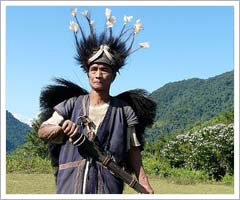Arunachal Pradesh Tribes
 Arunachal Pradesh the 24th state of the Indian Union is circumscribed by Bhutan to the west, Myanmar to the east, China to the north and north-east and the plains of Assam to the south. Arunachal Pradesh is acknowledged to be one of the most splendid, variegated and multilingual tribal areas of the world. Its strategic significance was demonstrated by the Chinese invasion in 1962, and the Indian government subsequently broke up the agency giving statehood to all the territories surrounding Assam. It is believed that sage Vyasa meditated here and also that the remains of the brick structure scattered around two villages in the hills north of Roing was the palace of Rukmini, the ensemble of Lord Krishna. The sixth Dalai Lama was also born on the soil of Arunachal Pradesh. Arunachal Pradesh the 24th state of the Indian Union is circumscribed by Bhutan to the west, Myanmar to the east, China to the north and north-east and the plains of Assam to the south. Arunachal Pradesh is acknowledged to be one of the most splendid, variegated and multilingual tribal areas of the world. Its strategic significance was demonstrated by the Chinese invasion in 1962, and the Indian government subsequently broke up the agency giving statehood to all the territories surrounding Assam. It is believed that sage Vyasa meditated here and also that the remains of the brick structure scattered around two villages in the hills north of Roing was the palace of Rukmini, the ensemble of Lord Krishna. The sixth Dalai Lama was also born on the soil of Arunachal Pradesh.
There are 26 major tribes and a number of sub tribes living in the state. Most of these communities are ethically similar but their geographical isolation from each other has brought amongst them certain distinctive characteristics in language, dress and customs.
The first group of people is the Monpas and the Sherdukpens of Tawang and West Kameng district. They follow the Lamaistic traditions of Mahayana Buddhism. Culturally similar to them are Membas and Khambas who live in the high mountains along the northern borders.
The second group of people Adis, Akas, Apatanis, Bangnis, Nishings, Mishmis, Mijis, .Tangsas, etc., who worship the sun and the moon namely Donyi Polo and Abotani, the original ancestor for most of these tribes.
The third group comprises of Noctes and Wanchos, adjoining Nagaland in the Tirap district. They are hard working people known for their structured village society in which the hereditary village chief still plays a vital role.
Arunachal Pradesh is not a linguistic state. It is an ethnic state inhabited by colourful tribal people of diverse culture and lifestyle. All of them have their own unique culture and traditions. They also have customary laws and a time tested dispute resolution mechanism. The disputes in tribal societies are resolved by a system of administration of justice founded on customs and customary laws of each tribe by the Village Council.
There are no written rules for administration of tribal villages, but the customs and traditions were almost compatible with the modern concepts of jurisprudence.
Shifting cultivation is traditional among the hill peoples of Arunachal Pradesh; rice, corn, maize, millet, and buckwheat are among the chief crops grown by this method. Millet and rice beer are popular, as tea. Some tribes supplement their diet by hunting, fishing, and gathering forest products. |